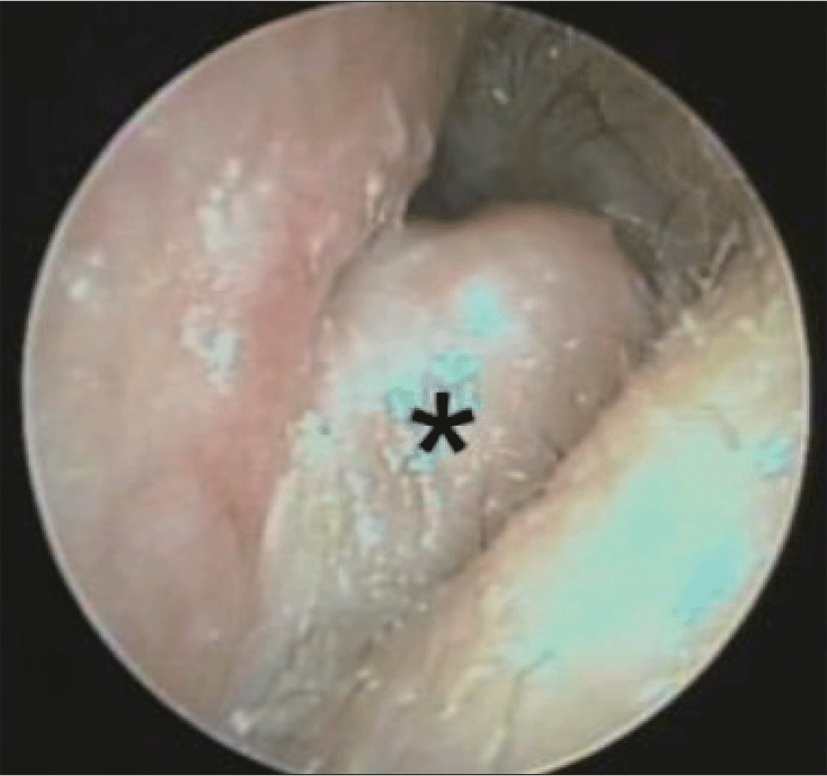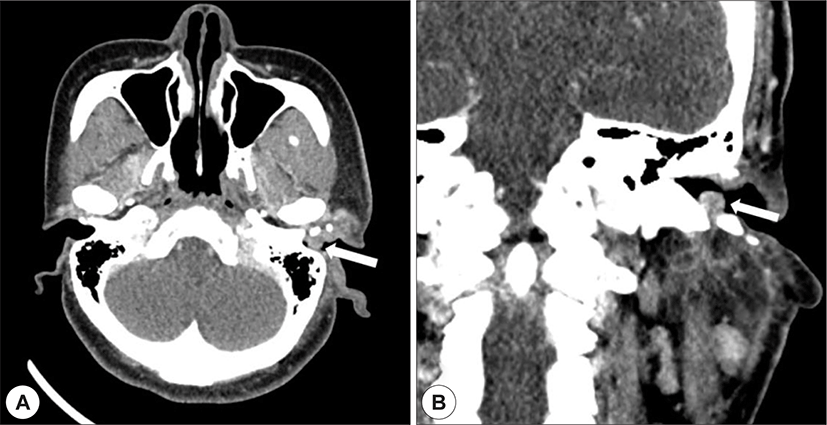Introduction
Cutaneous adnexal tumors are classified by their adnexal differentiation such as sebaceous, follicular, eccrine, and apocrine tumors. Unlike solid tumor such as ceruminous adenomas1) and ceruminous adenocarcinomas, cystic adnexal tumors are rarely reported in the external auditory canal (EAC).
Eccrine hydrocytoma (EH) was first reported in workers working in humid and warm environments in 1893.2) EHs are more prevalent in women than in men and generally occur in ages above 50. Central face, especially, lower lid is the most prevalent location. EHs are extremely rare in the EAC, with only a few cases reported in the English literature.3-5)
Hidrocystoma are considered a type of differentiated benign retention cyst.
Size and number of lesions can be affected by heat, humidity, and perspiration.6)
Here, we present a rare case of an EH, confined to the EAC in an adult female patient. The lesion was completely excised via transcanal endoscopic approach. The diagnosis of EH was made based on pathologic findings.
Case Report
A 43-year-old woman with a 4-year history of mass in the left EAC visited our outpatient department. She was otherwise healthy with no other significant medical problems. On otoendoscopic examination, she was found to have a soft, nontender, smooth, skin-colored mass about 0.5 cm in diameter in the anterior cartilagenous EAC (Fig. 1).

To evaluate the deep extent of the lesion, the patient underwent a Temporal bone computerized tomography scan (TB CT) with contract enhancement. TB CT demonstrates demonstrated a well-circumscribed 0.8×0.5 cm soft tissue cystic mass with partial obstruction of the left EAC. Though the cystic wall was slightly enhanced, cystic fluid showed low attenuation on contrast enhanced TB CT (Fig. 2). There was no evidence of invasion or destruction of surrounding soft tissues or bone.

Under the clinical impression of a benign soft tissue tumor, we performed an endoscopic transcanal excision of the mass with minimal surrounding margin. The mass was broadly attached to the anteroinferior surface of the EAC without involvement of the bony EAC or the auricular cartilage. The mass was extirpated without rupture. Minimal bleeding was encountered which was controlled with bipolar electric cauterization. The skin defect was covered by split thickness skin graft from postauricular area. The patient made an uneventful recovery and there was no recurrence during 3 months of follow-up.
Histopathologic examination revealed skin with multiple small dermal cysts with scattered normal sweat glands present between the cysts (Fig. 3A). On higher magnification, the cysts are lined by a flattened cuboidal double-layered epithelium (Fig. 3B). The histologic features are consistent with an EH.

Discussion
Differential diagnosis of solitary EH mainly includes the apocrine hydrocystoma, cystic and pigmented basal cell carcinoma, and cholesterol granuloma. However, they can be easily differentiated from the others by examining their histopathologic features. EH has the cysts lined with a cuboidal double-layered columnar epithelium and located in the dermis. Sweat glands are often scattered in the surroundings, as seen in histo-chemical PAS-negative study.
Most adnexal tumors are benign, but many have definite recurrence and malignant potential if incompletely excised. Invasive adnexal malignant tumors frequently extend radially through auricular cartilage and the fissures of Santorini into the parotid gland or into surrounding periauricular tissue.4)
The therapeutic options can be medical and/or surgical modalities. Solitary lesion can be successfully treated by surgical therapy. However, simple needle aspiration or incision and drainage can lead to recurrence.7) Therefore, complete total excision of cystic wall is the treatment of choice. For lesions limited to the external auditory canal, without involvement of the tympanic membrane or mastoid, endoscopic transcanal approaches are becoming increasingly popular. The advantage of an endoscopic approach is superior visualization of the tumor due to the wide-angle view. In our patient, the mass was completely surgically excised with endoscopic assistance, and the patency of the EAC was maintained without any surgical complications or recurrences.
However, multiple hidrocystomas (MEH) cannot be easily removed. For alternative therapy, topical atropine, scopolamine cream, botulinum toxin injection, CO2 laser ablation, or oral oxybutynin have been tried.8,9)
In conclusion, although primary tumors arising from the eccrine glands of EAC are extremely rare, EH should be considered as differential diagnosis. Diagnostic imaging by enhanced CT scan is necessary for defining the characteristics, extension of the lesion and for planning the therapeutic approach. Complete excision is recommended for this lesion.
